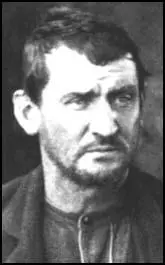Edman Spanger

Edman Spangler was born in York, Pennsylvania on 10th August, 1825. While at Bland School in York he met John Wilkes Booth. During the American Civil War Spangler moved to Washington where he found work as a carpenter and scene shifter at Ford's Theatre.
On 14th April, 1865, Spangler was involved in preparing the State Box for President Abraham Lincoln. During the work a fellow employee testified that Spangler was highly critical of the president.
After the assassination of Abraham Lincoln, a member of the audience, Jacob Ritterspaugh, claimed the Spangler hit him in the face in an attempt to stop him chasing after John Wilkes Booth. Spangler also said: "Don't say which way he went." Spangler was arrested by the police and charged with being part of the plot to kill the president.
On 1st May, 1865, President Andrew Johnson ordered the formation of a nine-man military commission to try the conspirators. It was argued by Edwin M. Stanton, the Secretary of War, that the men should be tried by a military court as Lincoln had been Commander in Chief of the army. Several members of the cabinet, including Gideon Welles (Secretary of the Navy), Edward Bates (Attorney General), Orville H. Browning (Secretary of the Interior), and Henry McCulloch (Secretary of the Treasury), disapproved, preferring a civil trial. However, James Speed, the Attorney General, agreed with Stanton and therefore the defendants did not enjoy the advantages of a jury trial.
The trial began on 10th May, 1865. The military commission included leading generals such as David Hunter, Lewis Wallace, Thomas Harris and Alvin Howe and Joseph Holt was the government's chief prosecutor. Mary Surratt, Lewis Powell, George Atzerodt, David Herold, Samuel Mudd, Michael O'Laughlin, Edman Spangler and Samuel Arnold were all charged with conspiring to murder Lincoln. During the trial Holt attempted to persuade the military commission that Jefferson Davis and the Confederate government had been involved in conspiracy.
Joseph Holt attempted to obscure the fact that there were two plots: the first to kidnap and the second to assassinate. It was important for the prosecution not to reveal the existence of a diary taken from the body of John Wilkes Booth. The diary made it clear that the assassination plan dated from 14th April. The defence surprisingly did not call for Booth's diary to be produced in court.
On 29th June, 1865, Spangler was found guilty of being involved in the conspiracy to murder Abraham Lincoln and was sentenced to six years in prison. Mary Surratt, Lewis Powell, George Atzerodt and David Herold were also found guilty of the crime and hanged at Washington Penitentiary on 7th July, 1865.
Spangler was sent to Fort Jefferson with fellow conspirators Samuel Mudd, Edman Spangler and Samuel Arnold. Spangler was pardoned by President Andrew Johnson on 1st March, 1869.
After his release from prison Spangler was given 5 acres of land to farm by Samuel Mudd. Edman Spangler also did carpentry work before his death on 7th February, 1875.
Primary Sources
(1) Joseph Burroughs worked as a carpenter and scene shifter at Ford's Theater in Washington. He gave evidence at Edman Spangler's trial on 16th May, 1865.
I was in the President's box that afternoon when Henry Ford was putting the flags around it. Harry Ford told me to go up with Spangler and take out the partition of the box; that the President and General Grant were coming there. While Spangler was at work removing it he said, "Damn the President and General Grant." I said to him, "What are you damning the man for - a man that has done no harm to you?" He said he ought to be cursed when he got so many men killed.
(2) Joseph Stewart was a member of the audience who attempted to capture John Wilkes Booth. He gave evidence at Edman Spangler's trial on 25th May, 1865.
I was at Ford's Theater on the night of the assassination of the President. I was sitting in the front-seat of the orchestra, on the right-hand side. The sharp report of a pistol at about half-past 10 startled me. I heard an exclamation, and simultaneously a man leaped from the President's box, lighting on the stage. He came down with his back slightly toward the audience, but rising and turning, his face came in full view. At the same instant I jumped on the stage, and the man disappeared at the left-hand stage entrance. I ran across the stage as quickly as possible, following the direction he took, calling out, "Stop that man!" three times.
Near the door on my right hand, I saw a man (Spangler) standing, who seemed to be turning, and who did not seem to be moving about like the others. I am satisfied that the person I saw inside the door was in a position and had an opportunity, if he had been disposed to do so, to have interrupted the exit of Booth.

